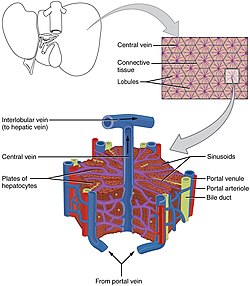| Lobules of liver | |
|---|---|
 The structure of the liver’s functional units or lobules. Blood enters the lobules through branches of the portal vein and hepatic artery proper, then flows through sinusoids. | |
| Details | |
| System | Digestive system |
| Location | Liver |
| Identifiers | |
| Latin | lobuli hepatis |
| TA98 | A05.8.01.056 |
| TA2 | 3060 |
| FMA | 76488 |
| Anatomical terms of microanatomy | |
In histology (microscopic anatomy), the lobules of liver, or hepatic lobules, are small divisions of the liver defined at the microscopic scale. The hepatic lobule is a building block of the liver tissue, consisting of a portal triad, hepatocytes arranged in linear cords between a capillary network, and a central vein.
Lobules are different from the lobes of liver: they are the smaller divisions of the lobes. The two-dimensional microarchitecture of the liver can be viewed from different perspectives:[1]
| Name | Shape | Model |
| classical lobule[2] | hexagonal; divided into concentric centrilobular, midzonal, periportal parts | anatomical |
| portal lobule[3] | triangular; centered on a portal triad | bile secretion |
| acinus [4] | elliptical or diamond-shaped; divided into zone I (periportal), zone II (transition zone), and zone III (pericentral) | blood flow and metabolic |
The term "hepatic lobule", without qualification, typically refers to the classical lobule.
- ^ Cell and Tissue Structure at U. Va.
- ^ Histology image: 88_03 at the University of Oklahoma Health Sciences Center
- ^ Histology image: 88_09a at the University of Oklahoma Health Sciences Center
- ^ Histology image: 88_09b at the University of Oklahoma Health Sciences Center
© MMXXIII Rich X Search. We shall prevail. All rights reserved. Rich X Search
